This essay is about a big dumb thing. Ubiquitous, yet barely registering in the universe of things deemed interesting, it was a weekly if not daily part of nineteenth-century Euro-American existence, particularly, but not exclusively, the world of men. Which is not to say that it was incidental to that world. On the contrary, it tended to dominate the public and private spaces in which it was situated, and was frequently engaged with, played upon, and circumvented. That thing was a billiard table, or more specifically green baize, the wool fabric that, typically in a saturated shade of green, covers a billiard table’s flat slate bed, extending to the side cushions against which billiard balls rebound during play. This essay posits that green baize and the practices of gaming, gambling, and chance that it enabled and signified had something to do with the forms that modernist painting began to take in the late nineteenth century, as well as with the ways that artists, critics, and art historians came to speak—and not to speak—about those forms.
Art historians have tended to ignore representations of green baize in their narratives of modernism. Although the implied materiality of the green baize supporting the games and bodies of Jean-Baptiste-Siméon Chardin’s card players might be said to underscore their absorptive states, Michael Fried says little about these striking green and green-blue planes, opting to focus rather on details such as an open drawer and a card facing outwards that the players seemingly ignore, but which the beholder cannot help but see (fig. 1).1 Similarly, the green baize covering Jean-Paul Marat’s writing surface barely registers in T. J. Clark’s analysis of Jacques-Louis David’s Death of Marat as a work of proto-modernism (fig. 2). It is the thing against which the “exquisite” shadow of Charlotte Corday’s letter is cast, but it is not among the “panoply of objects” worth mentioning, and not even interesting as an expansive midway point between the highly detailed grain of the depicted wood box and the relative matterlessness of the painting’s upper half.2 Such disinterest is not confined to contemporary art historians. Maurice Denis, comparing Paul Gauguin’s and Vincent van Gogh’s Night Cafés, both featuring billiard tables at the center of their radically different compositions, mentioned the bottle and the smoke, but not the table or its green baize (figs. 3, 4).3 And why should any of them have? In these instances green baize is mere incidental backdrop for absorptive play, for the contingencies of writing, revolution, and indeed painting itself, and for artists’ abilities to evoke different moods.
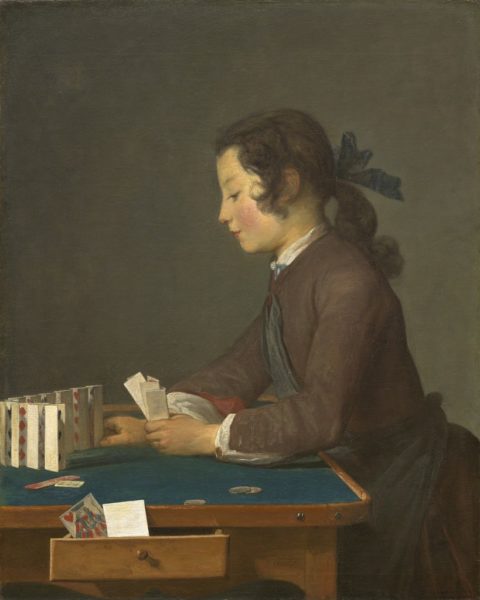
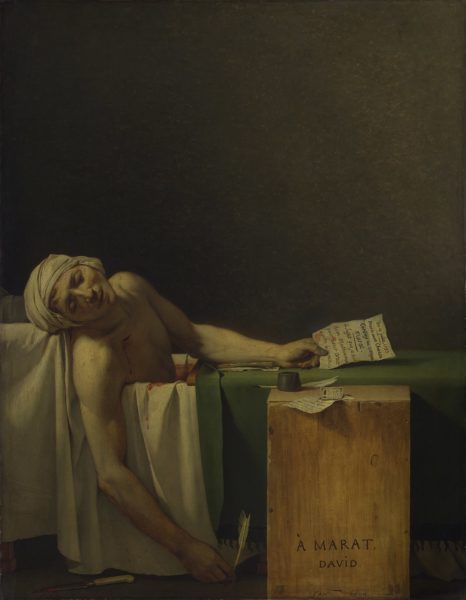
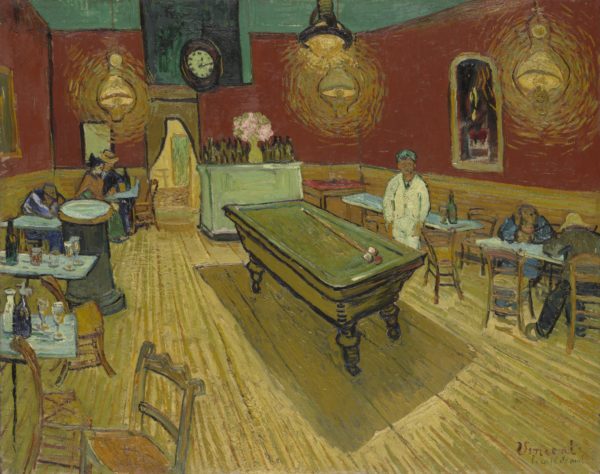
But the color green mattered in particular ways to modernist painters, and this paper will hazard that green baize did too. In painters’ own histories and theories of modernism, green was quickly superseded by yellow, blue, and red. When Denis first recounted the story, in 1903, of Gauguin’s lesson to Paul Sérusier, supposedly of some fifteen years earlier, he had Gauguin say: “How do you see that tree… green? Then use green, the most beautiful green on your palette; and that shadow, rather blue? Do not be afraid to paint it blue.”4 But in the much more dramatic retelling of the story in 1942, Denis had Sérusier seeing the trees differently: “How do you see these trees?” Gauguin asked. “They are yellow,” Sérusier supposedly replied. “So, put in yellow; this shadow, rather blue, paint it with pure ultramarine; these red leaves? Put in vermilion.”5 Also following in Gauguin’s footsteps in Pont-Aven, Henri Matisse mentioned that he had read an inscription in Marie Gloanec’s guest book, in which Gauguin attributed to Paul Cézanne the phrase: “a kilo of green is greener than half a kilo,” a maxim that Matisse would famously transform into “One square centimeter of some blue is not as blue as a square meter of the same blue.”6 Blue was the most spiritual and exalted color in Wassily Kandinsky’s aesthetic system, but he had no such love for saturated green, which he characterized as “sedate,” “tedious,” “immobile,” and “complacent.” “Pure green is to the realm of color,” Kandinsky wrote, “what the so-called bourgeoisie is to human society … like a fat, extremely healthy cow, lying motionless, fit only for chewing the cud, regarding the world with stupid, lackluster eyes.”7
If green was pertinent, then, for the genealogies and theories of Cézanne, Gauguin, and the early Denis, it was clearly impertinent in the writings of Matisse, Kandinsky, and the later Denis. Why did Denis change his story? What did Matisse’s quantity = quality equation gain or lose from being about blue rather than green (as well as about weight rather than surface area8)? And how could green, in Kandinsky’s gendered put-down, be like a fat cow? Increasingly part of the fabric of modern life, green baize obliquely suggests some answers to these questions. Especially on the billiard table, where its brilliant hue signified an imitation lawn, green baize harkens back to the green of nature. But in its intensity and artificiality, it also offers a very specific challenge to naturalistic representation, one that for some modern artists could be an opportunity. For what better way to counter naturalism than with the unnaturalness of the green baize, an intermediate gambit, I shall argue, prior to a more full-blown anti-naturalism.9 On this fake lawn, billiard balls were arranged and rearranged through a combination of will and chance, functioning, analogously to painting, as a literal field of contingency where nature and its vagaries were engaged and imagined to be managed, even mastered. Representations and evocations of the green baize thus suggest the fitfulness, the banalities, and once again the gendered valances of the apparent modernist break with a most materialist naturalism.10 Furthermore, these representations and evocations point to how some painters and art historians subsequently came to mystify that break. If green and the bourgeoisie could both be like extremely healthy fat cows, complacently and continuously eating green grass, seeing the world through uninspired and uninspiring eyes, lacking vitality and conviction, waiting only to be milked and inseminated, then it seems unsurprising that modernist painters might wish to transcend green; and that green baize, that most banal material experience of green, should hold little interest for art historians.
*
The history of green baize is a history of industrialization and of increasing consumption by the bourgeoisie and the working classes. Green baize lined and provided slightly cushioned surfaces for all sorts of everyday objects, including card tables, writing desks, boxes, chests of drawers, and interior doors.11 But by far the most familiar use for a large bolt of green baize was and still is on the billiard table, often known, synecdochically, simply as the green baize or in French the tapis vert.12 Table billiards, deriving from outdoor games played on a lawn such as croquet, is the umbrella term for a host of games broadly divided into two families, those played on tables with pockets, and those, known as carom billiards or sometimes as carambole, played on pocketless tables. While pocket billiards, or pool, became the most popular form of table billiards in North America, by far the most common type in nineteenth-century France, from where most of the examples in this paper are drawn, was carom billiards. Billiards was initially associated with the nobility and the upper classes. Louis XI was said to have had a billiard table, as was Mary, Queen of Scots, whose beheaded body was supposedly wrapped in the fabric ripped from the table she had played on in captivity.13 Louis XIV was shown playing billiards at court in 1694 (fig. 5), and about thirty years later the young Chardin depicted a well-heeled group of men and boys gathered around a billiard table in what appears to be a café (fig. 6). According to the Musée Carnavalet, the painting may have functioned as publicity for Chardin’s father, a cabinetmaker who made a name for himself supplying billiard equipment to the King.14 Less than a century later, Louis-Léopold Boilly tracked the “embourgeoisement” of the game, painting a relaxed scene of men, women, children, and dogs gathered around the tapis vert either in a private home or possibly in a commercial billiard hall (fig. 7).15 Far from the sordid atmosphere suggested towards the end of the century by Van Gogh’s Night Café, Boilly’s scene nevertheless delights in a certain sexual impropriety that in part turns on the ambiguity of the setting.16 Already by the early seventeenth century, as Chardin’s painting suggests, many Parisian cafés were said to have billiard tables,17 and, as Boilly’s painting implies, they proliferated in leisure spaces associated with a wide range of classes through the eighteenth and nineteenth centuries. The mass production of billiard equipment increased exponentially after 1870, when celluloid, derived from dried collodion, was patented after being developed as a substitute for expensive ivory billiard balls.18 By the end of the nineteenth century, as numerous postcards attest, billiard tables were to be found in nearly every café, bar, hotel, and military barracks in urban and not so urban centers across Europe, North America, and well beyond (fig. 8). Billiard tables were thus among the most commonplace and imposing things of modern life, centered in their spaces, lit dramatically, even garishly for optimal play, and often, as in Jean Béraud’s numerous depictions of billiard halls, forming the glowing focus of a room (fig. 9).
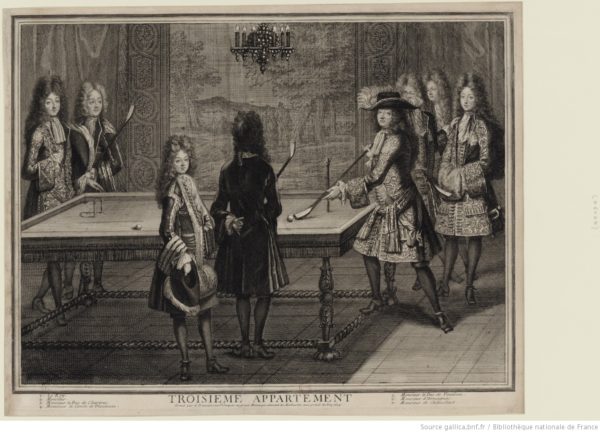
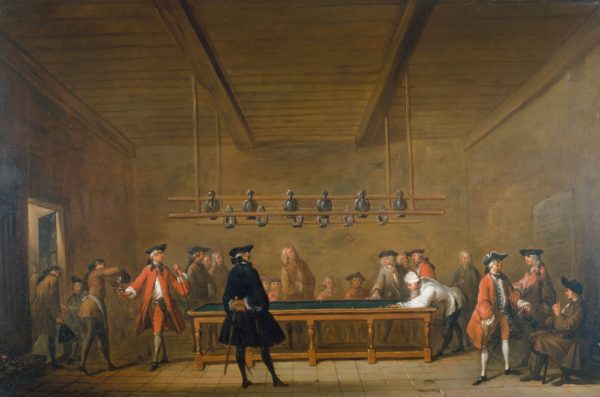
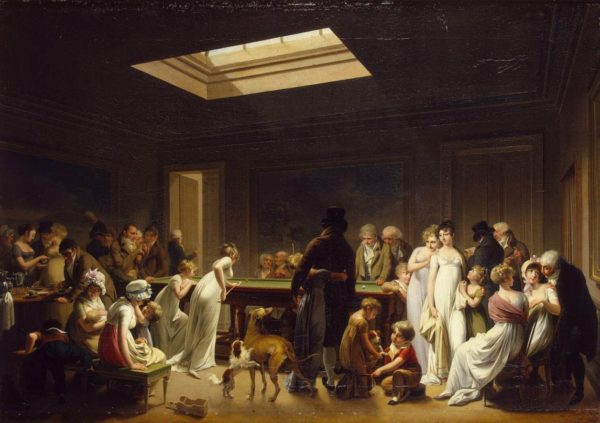
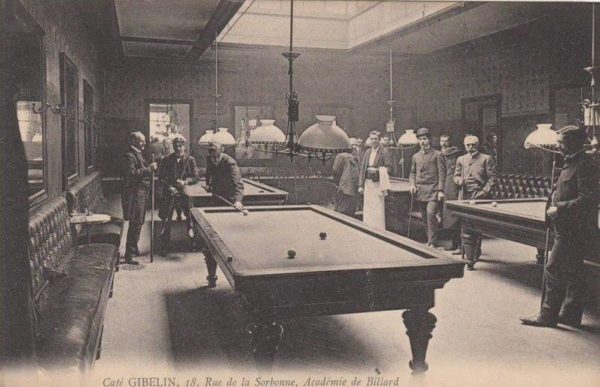
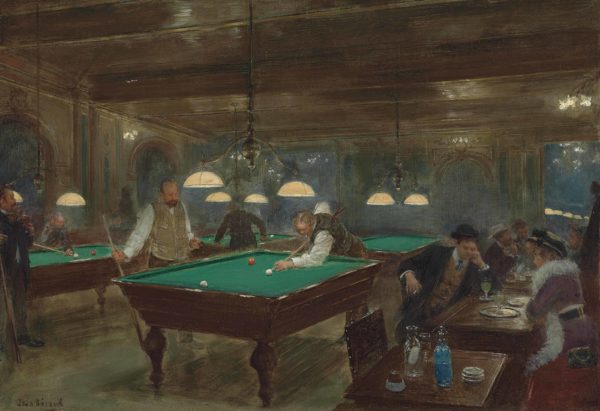
At the same time as they multiplied in public spaces of leisure, billiard tables continued to be found in large private homes, often in sumptuous billiard rooms purpose-decorated with the rich dark colors and heavy furniture that denoted masculine spaces.19 For Edgar Degas and Gustave Caillebotte, members of the upper-middle classes,20 the billiard table situated in the private home might be expected to have offered subject matter typical of modern male homosociality, but both artists seemed more interested in the formal challenges of depicting, on a rectangular support, a large rectangular prism-shaped object of a distinct color set in a cuboid space. In 1892, Degas wrote to an artist correspondent about how his paintings of the billiard room at a friend’s country house were attempts to unlearn and then relearn what he thought he knew about perspective.21 His first painting of The Billiard Room at Ménil-Hubert, considered a sketch for the second, presumably depicts the room more as it appeared to Degas, including a trio of billiard balls barely rendered three-dimensionally on the table and a customized carpet with a special rectangular cutout designed to offer underfooting for players while the table’s legs rested on a hard wood floor (fig. 10). With its rectangular doorway, rectangular pictures framed on the wall, the special carpet, and a beam of sunlight raking the surface and front edge of the table,22 the overall effect is indeed one of complex perspectival calculation licensed by the central object of the green baize, on which a red billiard ball appears to recede into space more as a function of its darker color rather than its size in comparison to the two white balls that read as further in the foreground. Degas evidently labored over the placement of the balls; faint traces of earlier positions for all three can still be perceived to the left of their final positions. In his second painting of the billiard room, Degas pushed the green baize much closer to the picture plane, even amputating one of the table’s legs, and significantly reduced the number of rectangles by cropping the composition more tightly, cutting off one side of the door frame on the left and a picture frame on the right, and replacing the customized carpet with blue and red taches that arbitrarily extend through the lower part of the painting (fig. 11). The beam of sunlight is gone, as are the billiard balls. The baize is partially drained of its green color, while the walls have taken on more of a greenish cast. The uninterrupted expanse of blue-green baize now takes center stage, but appears somewhat silenced in comparison to the loud active patterning of the carpet, an element that in many modernist accounts might have come to signify the “flatness” of the picture plane. This semi-mute interior evacuated of incidental detail, the direct antithesis of Béraud’s contemporary genre scenes, is a hybrid between a representational illusion of an actual space of leisure and a study of painterly surface prompted by the green baize. No beam of light, no balls, no players, and no fun interrupts the representation of the stubborn materiality of the billiard table’s cloth surface, which functions in uneasy contrast to the activated painterly surface of the “carpet.”
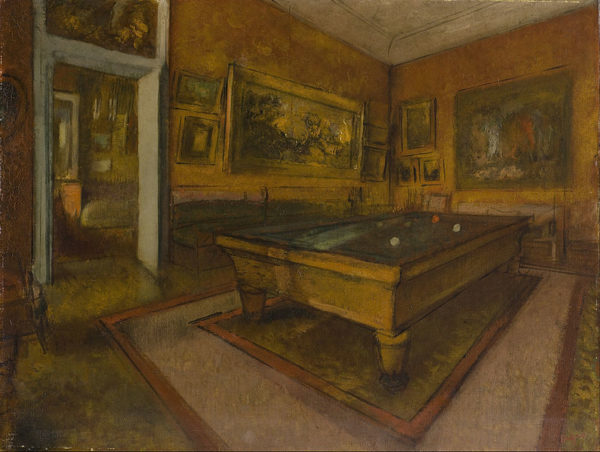
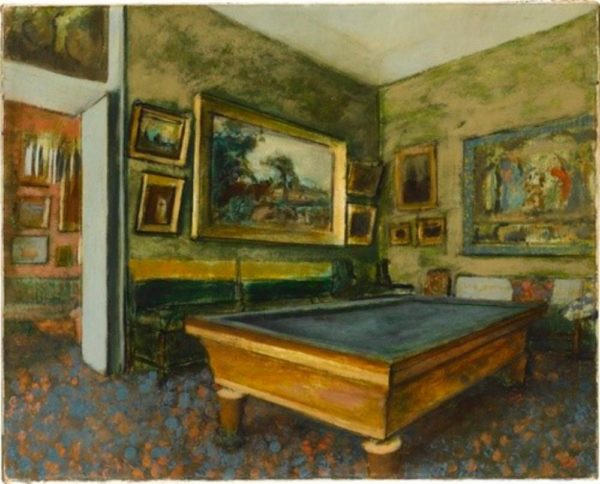
A special carpet with rectangular cut-out similar to the one depicted in Degas’s first billiard painting is more legible in Caillebotte’s earlier painting of the billiards room in his family’s country house at Yerres, and even more evident in recent photographs that show the room refurbished based on the work (fig. 12).23 Caillebotte left the painting, among his first known works, unfinished, most evidently on the left where the sides of the table as they recede into illusionistic space seem to have defeated him; the single line extending the foreground edge of the table gestures to the apparent failure. Without the left end of the table, without a cue in the lone player’s hands, and without the billiard balls that the player nevertheless seems to be lining up for a shot, the green baize swells and bulges as if the massive table cannot contain the plane of color. It is striking how the painting seems to come to a halt at the expanse of green at the center of the composition, to which the artificiality of the cue-less gesture draws the viewer’s attention. The surface on which play was about to happen has inadvertently become the subject of the painting, a reading amplified by the view through the windows and the open French doors, towards a cultivated garden whose “natural” yellow-green lawn throws the “fake” lawn of the billiard table inside into relief.24 Painted surface, in other words, seems discovered here by chance, through the banal prompt of the uninterrupted plane of green baize. The baize’s manufactured unnaturalness is starkly highlighted by the “natural” view out the window, but the implications of this discovery for modern painting are seemingly abandoned, the player left, literally, without a cue.
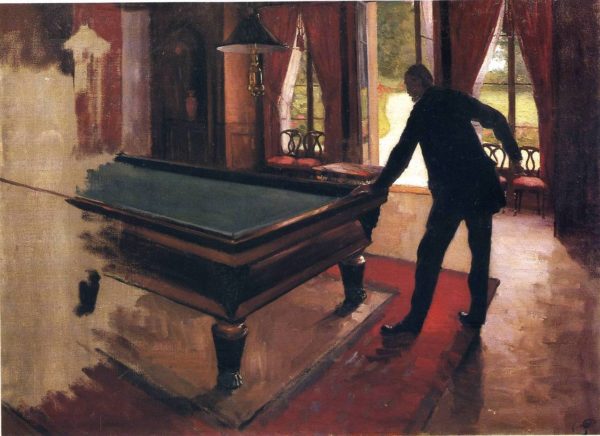
*
The manufacturing of baize goes back to the sixteenth century. A durable mid-weight to heavy woolen fabric, often worsted, baize is woven with an even nap resembling felt (fig. 13).25 It became particularly prized not only for its durability and texture but also for its abilities to absorb odor and muffle sound, hence its frequent use in religious environments and domestic spaces.26 The regular nap provides even friction, gripping smooth objects that might otherwise slide, slip, or roll more quickly on smoother fabric. Baize is thus ideal for billiard tables, and has been industrially produced by companies such as the Belgian firm Iwan Simonis specifically for billiards for over 300 years (fig. 14).27 (Most, if not all, baize for billiard tables was historically produced in Belgium and in England). It offers an even and calculable decelerating effect, especially on high end tables and those designed for competition, where the slate surface is heated to precisely control the friction. And it mutes the balls’ rebounds against the side cushions, such that the aural experience of gameplay is ideally restricted to the characteristic sounds of cues hitting balls and balls hitting each other. While baize has always come in various colors, green has long been the norm for gaming tables as well as for tables for counting money, and in part in this way the color green came to connote chance, luck, and fate.28 Green for baize is also supposed to be easier on the eyes than other colors especially under the incandescent lights of modernity, an important factor when the surface is as large as it is on a billiard table; green thus allows for longer play uninterrupted by eyestrain.29 Significantly for my argument, the standard bright green mimics the green of the original playing lawn, from which the table billiards surface derives, while at the same time explicitly signifying its manufactured artifice.

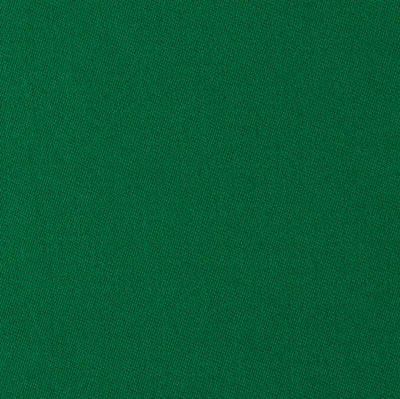
It can be easy to forget how brightly colored modern life could be in the nineteenth century, and to what extent, as Laura Anne Kalba has recently argued, nineteenth-century painters’ palettes, including Degas’s and Caillebotte’s, were mediated by industrially produced synthetic color.30 As modern chemical processes made bright, saturated hues more available to the masses, green baize was also brightened in color, as suggested by the difference between the relatively dark green baize of Chardin’s gaming tables and the brilliant, acidic greens of Béraud’s. As Michel Pastoureau points out, green had been an especially problematic color for the medieval dying trade, which placed restrictions on mixing blue and yellow.31 Additionally, green dyes, derived from the minerals malachite and verdigris, were notoriously difficult to fix; a bright green was expensive and even the best could fade to a dull khaki or darken to brown in only a few weeks.32 In the late eighteenth century, chemists developed brilliant, resilient, and much more affordable greens initially derived from arsenic, prompting the nineteenth-century fashion for bright greens in everything from wallpaper to candy to silk dresses. The new greens supported the proliferation of green baize-covered billiard tables, but also touched off concerns over a health crisis stemming from poisonous arsenical compounds, including those of an American doctor who compiled a book of dangerous wallpapers (fig. 15).33 Not to be underestimated is how differently people experienced these new synthetic greens and how closely they were associated with modernity, especially given that one of their touted advantages was their ability to give off the same bright color under different lighting conditions, including daylight, gas, and the new electrical lights.34
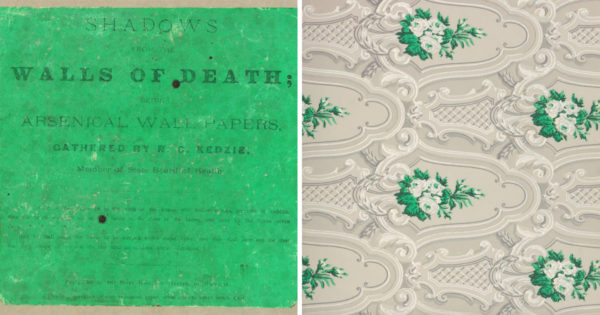
Large swaths of green baize, some but not all dyed with arsenical compounds,covered billiard tables, as well as wooden surfaces large and small in private and public spaces. Green baize offered strong contrast to rich wood tones, as if these pieces of furniture and small wooden objects had somehow retained their relationship not only to tree trunks but also to foliage. The tenuous connection between green baize and the natural world remained in play for a reviewer of the fourth impressionist exhibition of 1879. Claude Monet’s and Camille Pissarro’s landscapes, this reviewer complained, gave an “‘impression’ as of a heap of green baize… that is a field.” While a “heap” is hardly the taut expanse of cloth pulled over the slate bed of the billiard table, the critic nevertheless went on to evoke the colored balls on the tapis vert in his subsequent phrasing: “On the green baize are visible several disclosed streaks; and those, by reference to the catalogue, you will find out to be men and women. In the landscapes, Nature seems to have abdicated all her rights.”35 The critic was not responding to one specific painting, it seems, but to the ensemble of works exhibited that year by the two artists, the green baize effect of which might be summarized by Monet’s Parc Monceauand Pissarro’s Chemin sous bois, en été (figs. 16, 17).36 In this reviewer’s mind at least, nature, explicitly gendered female, was overruled in paintings that evoked an unnatural green baize belying the artists’ claims to be capturing their impressions of nature.37


Especially as it was used on a billiard table, green baize provided a unique opportunity to experience up close an expansive flat plane of unmodulated, brilliant green color with a soft, matte, even texture. On this playing field, if a game of straight rail carom billiards was set up, as it is in nearly all the paintings discussed here, including those by Boilly, Degas, Béraud, Van Gogh, and Gauguin, three perfectly spherical smooth balls, one red, two white or sometimes one red, one white, and one yellow, offered strong color contrast to the bright green. Straight-rail carom billiards involves scoring points by completing a carom, earned when a player’s cue ball strikes the other two balls on the table in one shot. Balls rarely, if ever, come to rest touching each other and when they do they touch at a nearly infinitesimally small point on their spherical surfaces. More often, there is a relatively large space between them in the countless arrangements possible on the baize and, as in Degas’s first painting of a billiard room, one’s sense of the position of the balls in space is informed not only by one’s point of view but also by the color of the balls against the unmodulated plane.
Billiard players, frequently in a state of intense concentration, lean over or even partially down on the table, touching it, smelling it, and as far as possible immersing themselves in this distinctive field of color to the point that their faces can take on a greenish cast. They draw back their cues to strike white or yellow orbs in such a way that a new pattern of colored orbs, to a large extent unpredictable, is produced against the green surface. In Félix Vallotton’s Les Raseurs(The Bores), one player leans far over the table while trying to keep one foot on the ground as per the rules, getting as close as possible to the green baize as his opponent, according to the caption, tries to throw him off his game by hurrying him along (fig. 18).38 A poster designed in 1910 by Eugène Ogé suggests that men who play billiards commune so closely and obsessively with the green baize that their heads might turn into billiard balls (fig. 19).
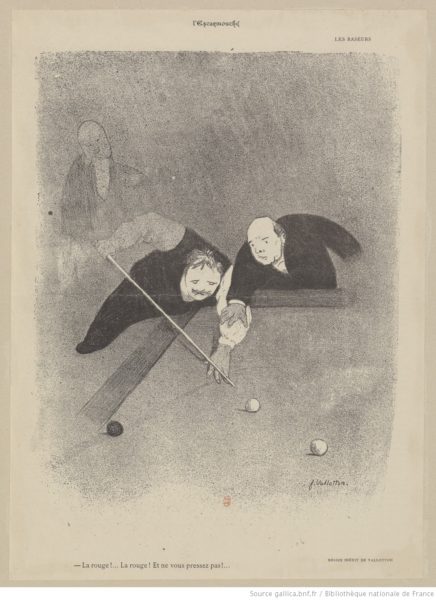
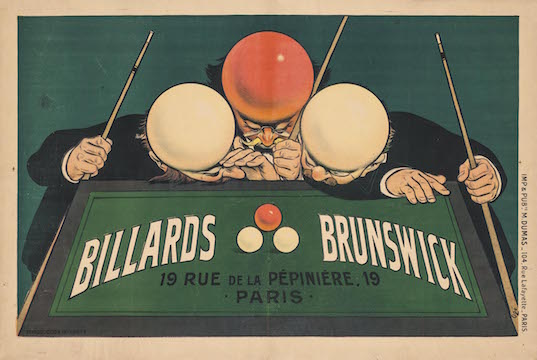
As Boilly’s scene of women and men playing billiards suggests and as I have already alluded, the game carries sexual connotations, in particular in the acts of leaning over, sitting, or even transgressing the rules and lying down on the green baize of the billiard table. Billiard equipment itself is highly sexualized; players play with balls and a cue, which in French is queue, also meaning tail and slang for penis. An especially crude Paris Commune-era caricature of the Empress Eugénie and Second Empire government officials makes the connections between billiard playing and sexual conquest evident (fig. 20). The Empress is depicted lying naked, except for her high boots, with her back arched, pelvis tilted, and her arms over her head, which hangs drunkenly over the side of a billiard table under which are scattered mostly champagne bottles. She is being leered at by Prince Napoléon, Napoléon III, and other political figures who lean on and grip the table while chalking their cues for play.39 The title of the work, La Poule, translates most commonly as “hen,” but also as “tart” or “floozy,” obviously referring to the Empress herself, who holds a tambourine, an apparent nod to paintings of seductive women by William-Adolphe Bouguereau and other artists patronized by Napoléon III. The caricature parodies paintings of nude women reclining in nature, laying the Empress out between the three billiard balls on the imitation lawn of the table, thus using the represented body of Eugénie to signal both her and the régime as unnatural and debauched. Its political import at the time of the Commune is clear, but the caricature also highlights the green baize as a masculine domain where nature, women, chance, and contingency are to be mastered.
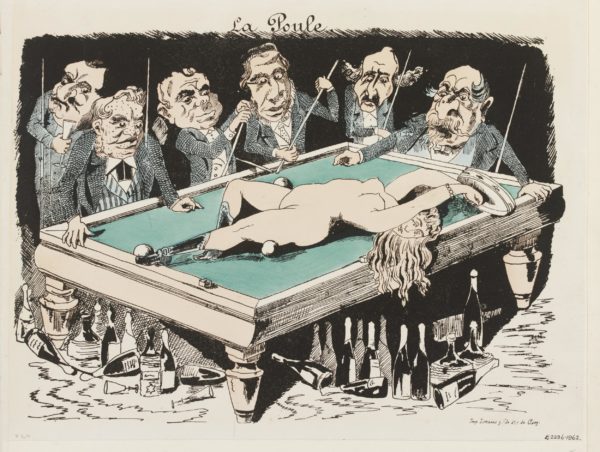
Highly skilled billiard players can, to a very high degree, predict and direct the patterns of the billiard balls after each shot, yet, even for these players, the shot of one’s opponent is much less predictable. For players of all skill levels, then, contingency is the name and a good part of the pleasure of the game. Engaging with and trying to manage risk and chance are the symbolic promises of billiards, a pleasure multiplied not only by the other delights—cards, drinking, women to ogle—often to be found in the spaces shared by the green baize, but also by the common practice, especially in the nineteenth and early twentieth centuries, of betting on the outcome.40 Gambling, in Walter Benjamin’s analysis, offers the opportunity to experience chance, a key, but usually obscured mechanism of capitalism, while paradoxically standing outside, if only temporarily, the socio-economic order by occupying the figure of the idle gambler, who earns or loses money contrary to the rules of a Protestant work ethic. Such symbolic “threshold experiences,” in the view of contemporary sociologists of gambling, offer the possibility of “cultural self-understanding,” a fleeting but nevertheless profound awareness of how chance and risk fundamentally structure human existence under capitalist modernity.41 In this context, Benjamin argued that the entire structure of modern capitalist success “predispose[s] the bourgeois to the gambler’s frame of mind,”42 so much so, he wrote, that the gambling table, “which is said to be green, like the golden tree of life, … [in] reality is as gray as asphalt.”43 In other words, according to Benjamin, the profound truth of the gambling table is that while it couches its joyful seductions in life-giving evergreen nature, it is in reality the quintessential common ground—the asphalt—of industrialized urban modernity.
When Degas represented a billiard room devoid of life, juxtaposing the mute surface of the table with the active painterly surface of the carpet, and when Caillebotte was halted by the green baize and effectively emasculated his billiard player by failing to paint his balls and cue, they both signaled the green baize and the surface of the canvas as unnatural playing fields, contingent grounds of modernity that had come to be problematic. While Degas and Caillebotte seemed to resist further managing or mastering the green baize, leaving it largely silent in Degas’s case, and unfinished in Caillebotte’s, later artists would come to ally the baize more closely with the modernist surface.
Modern artists continued to take up the motif of the billiard table at the fin-de-siècle, but a number approached the problem of its surface, initially at least (or so they said), with a concern for the psychophysiological effects of green baize and its associated aleatory forms of play on the viewer.The green baize of Paris fascinated the Norwegian artist Edvard Munch, who made numerous sketches of billiard tables after he arrived in the city in 1889 for an extended stay (figs. 21, 22). “I want to try to give an example of the incomprehensibility of color,” he wrote. “A billiard table. Walk into a billiard room. After you have looked at this intense green cloth for an hour, look up. How strangely everything around looks reddish. Those gentlemen you know were dressed in black, have now got crimson suits—and the room is reddish—walls and ceiling. After a while the suits are black again. If you want to paint this kind of mood—with a billiard table. You might as well paint it in crimson. If one is to paint the impression of the moment—the mood—humanity—then one must do that.”44 Despite a number of sketches and these extensive notes, or perhaps steering clear of Van Gogh’s precedent in the Night Café, Munch never seems to have managed to paint a billiard table. But he soon shifted his attention to the green baize of the roulette tables at Monte Carlo, which we more readily associate today with gambling (fig. 23).45 He painted them not in crimson as his notes suggested he might, but maintained and amplified their brilliant green hue with strong, punctuated contrasts of red, black, white, yellow, and an almost neon orange to evoke the atmosphere of the casino where he claimed to have observed numerous instances of what was termed “gambling mania.”46 In his most realized roulette painting the green baize is tipped towards the picture plane and stretched in both directions to take over the surface of the work in a form of modernist display, not unlike the way in which Van Gogh’s exaggerated perspective in the Night Café, among other things, begins to bring the surface of the billiard table towards the picture plane. This modernist act is precisely what Gauguin avoided in the Café at Arles, where the billiard table, in almost perfect perspective and with exquisitely rounded balls, occupies the middle ground of the rigidly composed and, in Denis’s words, almost “academic” composition.47 Here, in contrast to Degas’s and Caillebotte’s efforts, the green baize is carefully managed such that it no longer threatens to take over the picture plane.
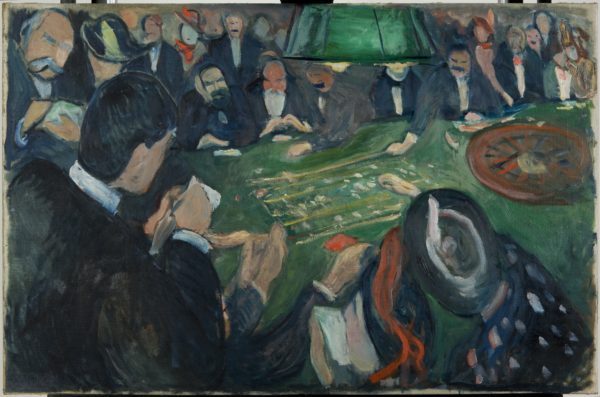
A few days after he put in an order to his brother for both Veronese and Emerald Green, Van Gogh described how, in the Night Café, he had attempted to “express the terrible human passions” of the setting by means of “an antithesis of the most different greens and reds.” Referring to this clash of colors, Van Gogh insisted that the color was not “locally true from the realist point of view … but a color suggesting some emotion, an ardent temperament.” While this is certainly the case for most of the colors in the painting, at a certain distance the surface of the billiard table, while reflecting the yellow of the gas lamp above it and including a number of different colors, resolves into a fairly bright, emerald green that was likely close to the color of the green baize itself, depicted somewhat darker in Gauguin’s painting, and in all its “realist trompe l’oeil”48—these are Van Gogh’s disdainful words—in Béraud’s scenes.
*
I have indulged somewhat in the banal details of green baize and billiards, in large part to demonstrate their unavoidable ubiquity. I return to my central argument in what follows. These large expanses of flat, matte green material were already unnaturalistic things highly familiar to those who frequented modern spaces of leisure. At the very least, these bright green artificial playing fields determined one’s trajectory through a room, perhaps receiving a passing glance. At the most they were played upon, with three colored balls enabling players to actually and symbolically engage with danger (through the association with arsenic), risk, and chance in a sexualized arena where soft green material provided the ground where nature and contingency were to be provoked and overcome with a cue. As such they offer an intriguing model for modernist practice as it challenged naturalism with unnaturalness, anti-naturalism, and even a new form of naturalism of the painted field itself, creative production and expression rather than reproduction and representation.49 The green baize is a flat field mimicking grass but evidently not grass, on which figures—balls—are arranged and rearranged using a stick through a combination of will and chance and as a form of play with a potential payoff for the winner who, despite all his willful acts, will never completely overcome the contingency of human existence. The ontology of chance is, of course, one of the key themes of Stéphane Mallarmé’s Un Coup de dés jamais n’abolira le hasard, a theme brought forth in part through a typographical arrangement whereby the “field”—the word is offered by Malcolm Bowie—where text is scattered and activated in ways that are tempting to read as analogous to the action on the billiard table.50
After Gauguin paraphrased Cézanne with the words later transformed by Matisse, he went on to argue that a painter, in the name of an intensity necessary to the practice of art, had to use more green to depict the green of nature: “since a kilo of green is greener than half a kilo, in order to achieve the equivalent (your canvas being smaller than life-size), you have to use a green greener than nature. There you have the truth behind the lie. That way, deriving its light from a subterfuge, a lie, your picture will be true to life since it will give you the impression of something real (light, strength, size), as varied in its harmonies as you could wish for.”51 The green baize of the billiard table was already the truth behind the lie, the material of modernity that was simultaneously both inescapably real (and real big) and as fake as fake could be. At this moment in the late nineteenth century the green baize, as in Munch’s, Van Gogh’s, and Gauguin’s paintings, lent itself to being rendered more or less naturalistically precisely because it was always already unnaturalistic. But more than that, it was a surface and a field of contingency that, when depicted by Degas and Caillebotte for instance, made the contingency of the painted surface all too obvious. It called out for mastery, a call to which Gauguin responded not only in his painting of the Café at Arles, but also perhaps parodically when he imagined himself as a champion billiard player representing France in a billiard match in New York on which “enormous sums are wagered.” In America, he wrote, he had heroically mastered chance and won the game by playing like a machine, “tock, tick, tock, just like that, slowly, evenly … the balls zig-zag, tock, tick, tock.”52
An anecdote from decades earlier has Gustave Courbet accusing Édouard Manet of painting women like playing cards, to which Manet apparently retorted that Courbet’s ideal figures—the caricature of Empress Eugénie springs to mind—were billiard balls.53 The joke was good as far as it went, but it did not let on that the two artists took aim at the same problem, the transposition of a three-dimensional world into a two-dimensional painted world. For this problem, playing cards, flat objects in three-dimensional space, were certainly an intriguing model, for Cézanne for instance,54 but three-dimensional billiard balls in the two-dimensional world of the green baize also appealed as a model for modernist painting. Émile Bernard, as Munch would do a few years later in the roulette painting, risked letting the green baize take over the painted surface in Breton Women in the Meadow (fig. 24). With no horizon line, and with any recession in space implied by the different sizes of the figures negated by the pervasiveness of the ground, Bernard crowded the painting with figures, as if the all-over greenish ground (Bernard called it “a meadow biased towards yellow green”55) was too intense and in need of mitigating. There are evocations of a billiard ball arrangement, such as the infinitesimal space between the curved black dress of the woman at the lower right and the Breton headdress immediately adjacent, and the especially ball-like women, dressed à la mode, in the upper left quadrant of the canvas.56 One of these fashionable female forms is rounded out by a red parasol with a handle that seems to connect to something held by her companion, another parasol perhaps, whose tip extends, queue-like, ever so slightly beyond the dark outline of her dress.
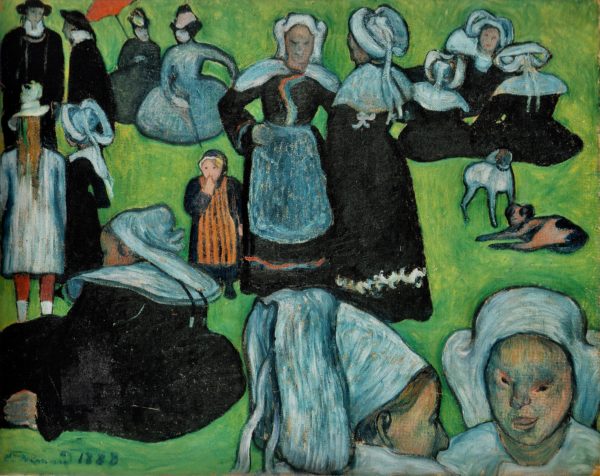
Another fin-de-siècle instance of a green baize-like ground occurs in a group of three paintings by Munch unified both by the themes of sickness and death and by their green walls and orange floors rendered with thinned paints soaked into the weave of the canvas for a distinct matte effect, a technique characteristic of Munch’s symbolist surfaces of the 1890s (figs. 25, 26, 27).57 The Swiss critic William Ritter, having seen the paintings at a solo exhibition of Munch’s work in Prague in 1905, was struck by Munch’s use of green, and in a highly self-conscious critical performance likened the three paintings to billiard tables and to the decelerating and muting effects of the green baize. “Oh! those silent rooms,” Ritter wrote, “those green empty rooms lit by an aquarium light filtered through snow that exaggerates the vivid orange of the waxed pine floors! Those naked rooms,” he went on, “where the sick and the mad err around a bed of rough wood or a single chair, like balls slowing down on the green felt [moleton (sic)] of a billiard table…”58 Ritter was not overall in favor of this kind of modernist practice, but was sufficiently intrigued to describe it at length, evoking the emptiness of the canvas, the sense of a matte surface, and the seemingly arbitrary placement of figures, that for him at least had as one model the green baize of the billiard table.


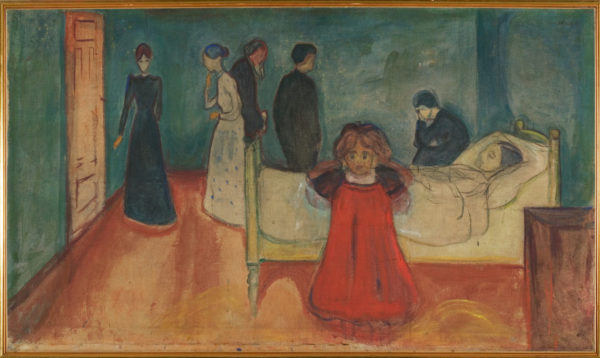
While Gauguin claimed to be the master of the billiard table, he only really dabbled in anti-naturalistic color; the Vision After the Sermon’s red field is the most obvious example, although it is mitigated by the recession into space denied to Bernard’s Breton women on their yellow-green field. Like Munch, he remained primarily concerned with an expanded or heightened concept of the real beyond appearances, the truth of which was in part to be signified by an unnaturalistic intensity of color, Cézanne’s kilo of green. And so Denis’s earliest telling of Gauguin’s lesson seems by far the most plausible; a tree “is” green (or in Gauguin’s manuscript “Diverses choses,” a tree trunk “is” blue-gray), but it “is” not anti-naturalistically yellow. A kilo of green to render nature thus makes sense, whereas a kilo of yellow would be outside the parameters of Gauguin’s “unnaturalism.” From this perspective, Denis’s seemingly minor change between the 1903 and the 1942 versions of the story is outrageous, but not surprising given what modern artists, sometimes proclaiming their triumphs over nature, had done in the intervening years. Early on Matisse recognized the limits of Gauguin/Cézanne’s kilo of green, and while retaining color referentiality in many of his paintings (the “sky” of Danceand Musicis blue; the “ground” is green), in theory he cut the thinnest of threads tying color to the real.59
The modernist green baize appeared recognizably in the form of the billiard table in later works by Man Ray, Georges Braque, and others,60 but was also evoked, in much transformed ways, in work by Pablo Picasso and indeed Matisse. Picasso’s Green Still Life and Glasses and Bottles from the summer of 1914 (figs. 28, 29) have been read by the biographically inclined as exuberant reflections of a happy, fertile time in Picasso’s life and career, with only slight hints of the war that began in late July.61 But the emerald green pervading the picture plane, an oddity in Picasso’s work, should instantly conjure up gaming and gambling, also signaled by the letters “JOU,” suggesting not only jouissance, but also jouer and joueur, fake grass, fake hope, and the inevitability of chance, linking Picasso’s work in yet another way to Mallarmé’s Un Coup de dés.62 Any imputed joyfulness in the “confetti” dots and the hits of red and yellow seems, from this perspective, just as factitious as the still life itself, the “lie that makes us realize truth,” in Picasso’s words echoing Gauguin ventriloquizing Cézanne.63 Matisse’s much later paintings Still Life with Shelland Still Life with a Magnolia, among what Yve-Alain Bois has called Matisse’s most “paratactic” works, do what Bernard could not quite bring himself to do, open up the space between figures such that the unifying ground, the field, becomes much more activated (fig. 30).64
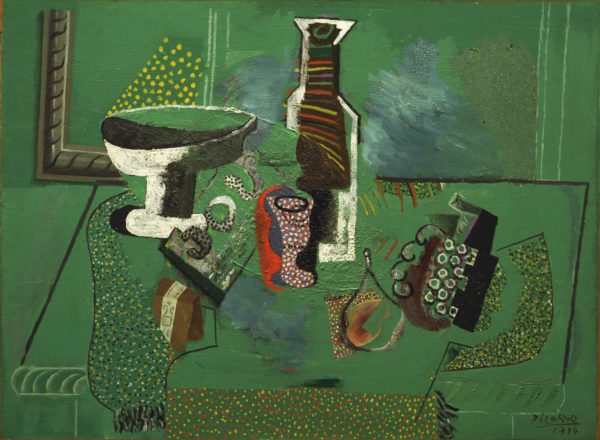
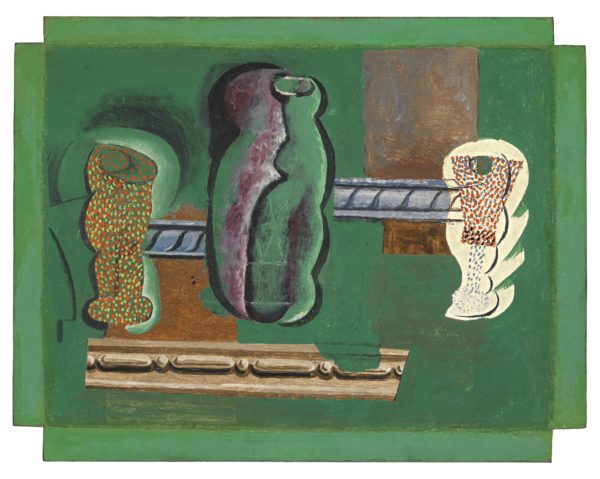
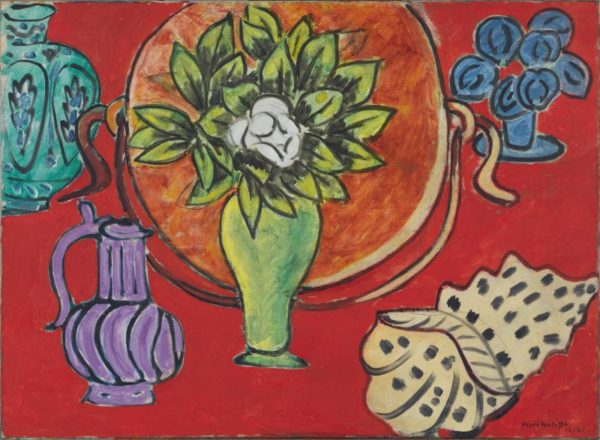
In the early 1950s, Alfred H. Barr, Jr. characterized Matisse’s picture making as “an act of will in a field of artifice.”65 Such a statement seems just as pertinent to billiards, that most banal and putatively wasteful of pastimes. Billiards reminds us that even the most willful and skillful shot (act) can have unintended and unpredictable consequences requiring further calculation and action. A ball landing here can throw the game off there; a missed shot can be a disaster or an opportunity. Artists who worked in this way—Matisse and Munch are perhaps among the most obvious examples—practiced a form of expression that involved constant adjustment and readjustment of the marks made to their supports. Billiards and green baize underscore that modernist practice, in other words, was not a field of action somehow separated from everyday modern life, but rather, as social historians of art have long argued, inescapably embedded in the material experiences of capitalist modernity that it also sought to critique, overcome, and even transcend. That the stuff of modern life was the stuff of modern painting is a familiar argument, but its banal consequences—green baize as modernist model, for instance—continue to meet the resistance of its earliest deniers.
All of the mundane, even offensive qualities of green baize, its resolute materiality, its potential toxicity, its decelerating and silencing effects on items of play, its easiness on players’ eyes, its associations with the bourgeois interior, and with forms of leisure such as billiards and gambling that were increasingly moralized and pathologized, turned up in Kandinsky’s full-throated rejection of green as bourgeois and cow-like. Significantly,one of the most frequently reproduced depictions of green baize is not Van Gogh’s Night Café or any of the other works mentioned here, but Cassius Marcellus Coolidge’s series of dogs in upper-middle-class get-ups gathered together to play pool and poker, licensed for mass reproduction by an American advertising firm aiming at aspirational working-class audiences (figs. 31, 32, 33).66 Only a few years later came Kandinsky’s repudiation of green and his savaging of the bourgeoisie, worth quoting again, now at length: “Absolute green is the most sedate color there is… It moves in no direction at all, has no overtones of joy or sorrow or passion, demands nothing, calls out to no one. This continual absence of movement is a property that has a beneficial effect upon tired people and tired souls, but which after a certain period of repose can easily become tedious… Passivity is the most characteristic quality of absolute green, a quality tainted by a kind of unctuous air of self-satisfaction. Thus, pure green is to the realm of color what the so-called bourgeoisie is to human society; it is immobile, complacent, limited in every respect. This green is like a fat, extremely healthy cow, lying motionless, fit only for chewing the cud, regarding the world with stupid, lackluster eyes.”67 Kandinsky’s crude and hyperbolic feminization of green suggested that in his ideal world, nature and any distinction between figure and ground were to be heroically, even violently overcome, that the “fat healthy cow” with the “stupid eyes” was, like the Empress Eugénie lying drunk and naked on the billiard table, to be sexually violated into oblivion.
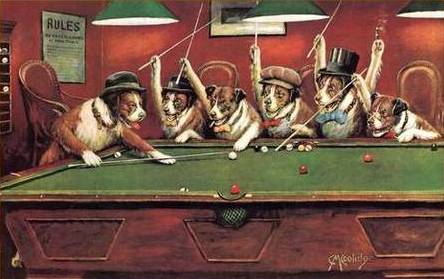

It was neither Coolidge’s dogs nor Kandinsky’s distaste for green that in and of themselves drove green baize and many of its associated activities, most notably gambling, outside of the scholarly realm. It is rather part and parcel of the very nature of green baize itself, to which Coolidge’s and Kandinsky’s representations point. It is entirely banal, stubbornly material, and nothing but itself, in other words one of the most modern things I can think of. It cannot be transcended or transformed, only ignored. When I said at the outset that this was an essay about a big dumb thing, I meant it sincerely, and I meant it at least in part to counter the scholarly impetus towards analyzing clever objects in order to reclaim the stubborn materiality of things, including modernist painting itself.68 While highlighting those moments that the green baize has been represented or evoked in modernist practice as a model field of contingency, I have also wanted to retain its everyday background thingness, its utter, even offensive banality. It is neither clever nor anti-clever, but mute and even muting. Green baize is, extrapolating from Benjamin’s writings on gambling, something like modernism’s asphalt, the manufactured ground we drive over without giving it so much as a second thought. It is precisely the kind of thing about which art history, and art historical narratives of modernism, have tended to care less.
Notes
Notes
This essay is about a big dumb thing. Ubiquitous, yet barely registering in the universe of things deemed interesting, it was a weekly if not daily part of nineteenth-century Euro-American existence, particularly, but not exclusively, the world of men. Which is not to say that it was incidental to that world. On the contrary, it tended to dominate the public and private spaces in which it was situated, and was frequently engaged with, played upon, and circumvented. That thing was a billiard table, or more specifically green baize, the wool fabric that, typically in a saturated shade of green, covers a billiard table’s flat slate bed, extending to the side cushions against which billiard balls rebound during play. This essay posits that green baize and the practices of gaming, gambling, and chance that it enabled and signified had something to do with the forms that modernist painting began to take in the late nineteenth century, as well as with the ways that artists, critics, and art historians came to speak—and not to speak—about those forms.
Art historians have tended to ignore representations of green baize in their narratives of modernism. Although the implied materiality of the green baize supporting the games and bodies of Jean-Baptiste-Siméon Chardin’s card players might be said to underscore their absorptive states, Michael Fried says little about these striking green and green-blue planes, opting to focus rather on details such as an open drawer and a card facing outwards that the players seemingly ignore, but which the beholder cannot help but see (fig. 1).1 Similarly, the green baize covering Jean-Paul Marat’s writing surface barely registers in T. J. Clark’s analysis of Jacques-Louis David’s Death of Marat as a work of proto-modernism (fig. 2). It is the thing against which the “exquisite” shadow of Charlotte Corday’s letter is cast, but it is not among the “panoply of objects” worth mentioning, and not even interesting as an expansive midway point between the highly detailed grain of the depicted wood box and the relative matterlessness of the painting’s upper half.2 Such disinterest is not confined to contemporary art historians. Maurice Denis, comparing Paul Gauguin’s and Vincent van Gogh’s Night Cafés, both featuring billiard tables at the center of their radically different compositions, mentioned the bottle and the smoke, but not the table or its green baize (figs. 3, 4).3 And why should any of them have? In these instances green baize is mere incidental backdrop for absorptive play, for the contingencies of writing, revolution, and indeed painting itself, and for artists’ abilities to evoke different moods.



But the color green mattered in particular ways to modernist painters, and this paper will hazard that green baize did too. In painters’ own histories and theories of modernism, green was quickly superseded by yellow, blue, and red. When Denis first recounted the story, in 1903, of Gauguin’s lesson to Paul Sérusier, supposedly of some fifteen years earlier, he had Gauguin say: “How do you see that tree… green? Then use green, the most beautiful green on your palette; and that shadow, rather blue? Do not be afraid to paint it blue.”4 But in the much more dramatic retelling of the story in 1942, Denis had Sérusier seeing the trees differently: “How do you see these trees?” Gauguin asked. “They are yellow,” Sérusier supposedly replied. “So, put in yellow; this shadow, rather blue, paint it with pure ultramarine; these red leaves? Put in vermilion.”5 Also following in Gauguin’s footsteps in Pont-Aven, Henri Matisse mentioned that he had read an inscription in Marie Gloanec’s guest book, in which Gauguin attributed to Paul Cézanne the phrase: “a kilo of green is greener than half a kilo,” a maxim that Matisse would famously transform into “One square centimeter of some blue is not as blue as a square meter of the same blue.”6 Blue was the most spiritual and exalted color in Wassily Kandinsky’s aesthetic system, but he had no such love for saturated green, which he characterized as “sedate,” “tedious,” “immobile,” and “complacent.” “Pure green is to the realm of color,” Kandinsky wrote, “what the so-called bourgeoisie is to human society … like a fat, extremely healthy cow, lying motionless, fit only for chewing the cud, regarding the world with stupid, lackluster eyes.”7
If green was pertinent, then, for the genealogies and theories of Cézanne, Gauguin, and the early Denis, it was clearly impertinent in the writings of Matisse, Kandinsky, and the later Denis. Why did Denis change his story? What did Matisse’s quantity = quality equation gain or lose from being about blue rather than green (as well as about weight rather than surface area8)? And how could green, in Kandinsky’s gendered put-down, be like a fat cow? Increasingly part of the fabric of modern life, green baize obliquely suggests some answers to these questions. Especially on the billiard table, where its brilliant hue signified an imitation lawn, green baize harkens back to the green of nature. But in its intensity and artificiality, it also offers a very specific challenge to naturalistic representation, one that for some modern artists could be an opportunity. For what better way to counter naturalism than with the unnaturalness of the green baize, an intermediate gambit, I shall argue, prior to a more full-blown anti-naturalism.9 On this fake lawn, billiard balls were arranged and rearranged through a combination of will and chance, functioning, analogously to painting, as a literal field of contingency where nature and its vagaries were engaged and imagined to be managed, even mastered. Representations and evocations of the green baize thus suggest the fitfulness, the banalities, and once again the gendered valances of the apparent modernist break with a most materialist naturalism.10 Furthermore, these representations and evocations point to how some painters and art historians subsequently came to mystify that break. If green and the bourgeoisie could both be like extremely healthy fat cows, complacently and continuously eating green grass, seeing the world through uninspired and uninspiring eyes, lacking vitality and conviction, waiting only to be milked and inseminated, then it seems unsurprising that modernist painters might wish to transcend green; and that green baize, that most banal material experience of green, should hold little interest for art historians.
*
The history of green baize is a history of industrialization and of increasing consumption by the bourgeoisie and the working classes. Green baize lined and provided slightly cushioned surfaces for all sorts of everyday objects, including card tables, writing desks, boxes, chests of drawers, and interior doors.11 But by far the most familiar use for a large bolt of green baize was and still is on the billiard table, often known, synecdochically, simply as the green baize or in French the tapis vert.12 Table billiards, deriving from outdoor games played on a lawn such as croquet, is the umbrella term for a host of games broadly divided into two families, those played on tables with pockets, and those, known as carom billiards or sometimes as carambole, played on pocketless tables. While pocket billiards, or pool, became the most popular form of table billiards in North America, by far the most common type in nineteenth-century France, from where most of the examples in this paper are drawn, was carom billiards. Billiards was initially associated with the nobility and the upper classes. Louis XI was said to have had a billiard table, as was Mary, Queen of Scots, whose beheaded body was supposedly wrapped in the fabric ripped from the table she had played on in captivity.13 Louis XIV was shown playing billiards at court in 1694 (fig. 5), and about thirty years later the young Chardin depicted a well-heeled group of men and boys gathered around a billiard table in what appears to be a café (fig. 6). According to the Musée Carnavalet, the painting may have functioned as publicity for Chardin’s father, a cabinetmaker who made a name for himself supplying billiard equipment to the King.14 Less than a century later, Louis-Léopold Boilly tracked the “embourgeoisement” of the game, painting a relaxed scene of men, women, children, and dogs gathered around the tapis vert either in a private home or possibly in a commercial billiard hall (fig. 7).15 Far from the sordid atmosphere suggested towards the end of the century by Van Gogh’s Night Café, Boilly’s scene nevertheless delights in a certain sexual impropriety that in part turns on the ambiguity of the setting.16 Already by the early seventeenth century, as Chardin’s painting suggests, many Parisian cafés were said to have billiard tables,17 and, as Boilly’s painting implies, they proliferated in leisure spaces associated with a wide range of classes through the eighteenth and nineteenth centuries. The mass production of billiard equipment increased exponentially after 1870, when celluloid, derived from dried collodion, was patented after being developed as a substitute for expensive ivory billiard balls.18 By the end of the nineteenth century, as numerous postcards attest, billiard tables were to be found in nearly every café, bar, hotel, and military barracks in urban and not so urban centers across Europe, North America, and well beyond (fig. 8). Billiard tables were thus among the most commonplace and imposing things of modern life, centered in their spaces, lit dramatically, even garishly for optimal play, and often, as in Jean Béraud’s numerous depictions of billiard halls, forming the glowing focus of a room (fig. 9).





At the same time as they multiplied in public spaces of leisure, billiard tables continued to be found in large private homes, often in sumptuous billiard rooms purpose-decorated with the rich dark colors and heavy furniture that denoted masculine spaces.19 For Edgar Degas and Gustave Caillebotte, members of the upper-middle classes,20 the billiard table situated in the private home might be expected to have offered subject matter typical of modern male homosociality, but both artists seemed more interested in the formal challenges of depicting, on a rectangular support, a large rectangular prism-shaped object of a distinct color set in a cuboid space. In 1892, Degas wrote to an artist correspondent about how his paintings of the billiard room at a friend’s country house were attempts to unlearn and then relearn what he thought he knew about perspective.21 His first painting of The Billiard Room at Ménil-Hubert, considered a sketch for the second, presumably depicts the room more as it appeared to Degas, including a trio of billiard balls barely rendered three-dimensionally on the table and a customized carpet with a special rectangular cutout designed to offer underfooting for players while the table’s legs rested on a hard wood floor (fig. 10). With its rectangular doorway, rectangular pictures framed on the wall, the special carpet, and a beam of sunlight raking the surface and front edge of the table,22 the overall effect is indeed one of complex perspectival calculation licensed by the central object of the green baize, on which a red billiard ball appears to recede into space more as a function of its darker color rather than its size in comparison to the two white balls that read as further in the foreground. Degas evidently labored over the placement of the balls; faint traces of earlier positions for all three can still be perceived to the left of their final positions. In his second painting of the billiard room, Degas pushed the green baize much closer to the picture plane, even amputating one of the table’s legs, and significantly reduced the number of rectangles by cropping the composition more tightly, cutting off one side of the door frame on the left and a picture frame on the right, and replacing the customized carpet with blue and red taches that arbitrarily extend through the lower part of the painting (fig. 11). The beam of sunlight is gone, as are the billiard balls. The baize is partially drained of its green color, while the walls have taken on more of a greenish cast. The uninterrupted expanse of blue-green baize now takes center stage, but appears somewhat silenced in comparison to the loud active patterning of the carpet, an element that in many modernist accounts might have come to signify the “flatness” of the picture plane. This semi-mute interior evacuated of incidental detail, the direct antithesis of Béraud’s contemporary genre scenes, is a hybrid between a representational illusion of an actual space of leisure and a study of painterly surface prompted by the green baize. No beam of light, no balls, no players, and no fun interrupts the representation of the stubborn materiality of the billiard table’s cloth surface, which functions in uneasy contrast to the activated painterly surface of the “carpet.”


A special carpet with rectangular cut-out similar to the one depicted in Degas’s first billiard painting is more legible in Caillebotte’s earlier painting of the billiards room in his family’s country house at Yerres, and even more evident in recent photographs that show the room refurbished based on the work (fig. 12).23 Caillebotte left the painting, among his first known works, unfinished, most evidently on the left where the sides of the table as they recede into illusionistic space seem to have defeated him; the single line extending the foreground edge of the table gestures to the apparent failure. Without the left end of the table, without a cue in the lone player’s hands, and without the billiard balls that the player nevertheless seems to be lining up for a shot, the green baize swells and bulges as if the massive table cannot contain the plane of color. It is striking how the painting seems to come to a halt at the expanse of green at the center of the composition, to which the artificiality of the cue-less gesture draws the viewer’s attention. The surface on which play was about to happen has inadvertently become the subject of the painting, a reading amplified by the view through the windows and the open French doors, towards a cultivated garden whose “natural” yellow-green lawn throws the “fake” lawn of the billiard table inside into relief.24 Painted surface, in other words, seems discovered here by chance, through the banal prompt of the uninterrupted plane of green baize. The baize’s manufactured unnaturalness is starkly highlighted by the “natural” view out the window, but the implications of this discovery for modern painting are seemingly abandoned, the player left, literally, without a cue.

*
The manufacturing of baize goes back to the sixteenth century. A durable mid-weight to heavy woolen fabric, often worsted, baize is woven with an even nap resembling felt (fig. 13).25 It became particularly prized not only for its durability and texture but also for its abilities to absorb odor and muffle sound, hence its frequent use in religious environments and domestic spaces.26 The regular nap provides even friction, gripping smooth objects that might otherwise slide, slip, or roll more quickly on smoother fabric. Baize is thus ideal for billiard tables, and has been industrially produced by companies such as the Belgian firm Iwan Simonis specifically for billiards for over 300 years (fig. 14).27 (Most, if not all, baize for billiard tables was historically produced in Belgium and in England). It offers an even and calculable decelerating effect, especially on high end tables and those designed for competition, where the slate surface is heated to precisely control the friction. And it mutes the balls’ rebounds against the side cushions, such that the aural experience of gameplay is ideally restricted to the characteristic sounds of cues hitting balls and balls hitting each other. While baize has always come in various colors, green has long been the norm for gaming tables as well as for tables for counting money, and in part in this way the color green came to connote chance, luck, and fate.28 Green for baize is also supposed to be easier on the eyes than other colors especially under the incandescent lights of modernity, an important factor when the surface is as large as it is on a billiard table; green thus allows for longer play uninterrupted by eyestrain.29 Significantly for my argument, the standard bright green mimics the green of the original playing lawn, from which the table billiards surface derives, while at the same time explicitly signifying its manufactured artifice.


It can be easy to forget how brightly colored modern life could be in the nineteenth century, and to what extent, as Laura Anne Kalba has recently argued, nineteenth-century painters’ palettes, including Degas’s and Caillebotte’s, were mediated by industrially produced synthetic color.30 As modern chemical processes made bright, saturated hues more available to the masses, green baize was also brightened in color, as suggested by the difference between the relatively dark green baize of Chardin’s gaming tables and the brilliant, acidic greens of Béraud’s. As Michel Pastoureau points out, green had been an especially problematic color for the medieval dying trade, which placed restrictions on mixing blue and yellow.31 Additionally, green dyes, derived from the minerals malachite and verdigris, were notoriously difficult to fix; a bright green was expensive and even the best could fade to a dull khaki or darken to brown in only a few weeks.32 In the late eighteenth century, chemists developed brilliant, resilient, and much more affordable greens initially derived from arsenic, prompting the nineteenth-century fashion for bright greens in everything from wallpaper to candy to silk dresses. The new greens supported the proliferation of green baize-covered billiard tables, but also touched off concerns over a health crisis stemming from poisonous arsenical compounds, including those of an American doctor who compiled a book of dangerous wallpapers (fig. 15).33 Not to be underestimated is how differently people experienced these new synthetic greens and how closely they were associated with modernity, especially given that one of their touted advantages was their ability to give off the same bright color under different lighting conditions, including daylight, gas, and the new electrical lights.34

Large swaths of green baize, some but not all dyed with arsenical compounds,covered billiard tables, as well as wooden surfaces large and small in private and public spaces. Green baize offered strong contrast to rich wood tones, as if these pieces of furniture and small wooden objects had somehow retained their relationship not only to tree trunks but also to foliage. The tenuous connection between green baize and the natural world remained in play for a reviewer of the fourth impressionist exhibition of 1879. Claude Monet’s and Camille Pissarro’s landscapes, this reviewer complained, gave an “‘impression’ as of a heap of green baize… that is a field.” While a “heap” is hardly the taut expanse of cloth pulled over the slate bed of the billiard table, the critic nevertheless went on to evoke the colored balls on the tapis vert in his subsequent phrasing: “On the green baize are visible several disclosed streaks; and those, by reference to the catalogue, you will find out to be men and women. In the landscapes, Nature seems to have abdicated all her rights.”35 The critic was not responding to one specific painting, it seems, but to the ensemble of works exhibited that year by the two artists, the green baize effect of which might be summarized by Monet’s Parc Monceauand Pissarro’s Chemin sous bois, en été (figs. 16, 17).36 In this reviewer’s mind at least, nature, explicitly gendered female, was overruled in paintings that evoked an unnatural green baize belying the artists’ claims to be capturing their impressions of nature.37


Especially as it was used on a billiard table, green baize provided a unique opportunity to experience up close an expansive flat plane of unmodulated, brilliant green color with a soft, matte, even texture. On this playing field, if a game of straight rail carom billiards was set up, as it is in nearly all the paintings discussed here, including those by Boilly, Degas, Béraud, Van Gogh, and Gauguin, three perfectly spherical smooth balls, one red, two white or sometimes one red, one white, and one yellow, offered strong color contrast to the bright green. Straight-rail carom billiards involves scoring points by completing a carom, earned when a player’s cue ball strikes the other two balls on the table in one shot. Balls rarely, if ever, come to rest touching each other and when they do they touch at a nearly infinitesimally small point on their spherical surfaces. More often, there is a relatively large space between them in the countless arrangements possible on the baize and, as in Degas’s first painting of a billiard room, one’s sense of the position of the balls in space is informed not only by one’s point of view but also by the color of the balls against the unmodulated plane.
Billiard players, frequently in a state of intense concentration, lean over or even partially down on the table, touching it, smelling it, and as far as possible immersing themselves in this distinctive field of color to the point that their faces can take on a greenish cast. They draw back their cues to strike white or yellow orbs in such a way that a new pattern of colored orbs, to a large extent unpredictable, is produced against the green surface. In Félix Vallotton’s Les Raseurs(The Bores), one player leans far over the table while trying to keep one foot on the ground as per the rules, getting as close as possible to the green baize as his opponent, according to the caption, tries to throw him off his game by hurrying him along (fig. 18).38 A poster designed in 1910 by Eugène Ogé suggests that men who play billiards commune so closely and obsessively with the green baize that their heads might turn into billiard balls (fig. 19).


As Boilly’s scene of women and men playing billiards suggests and as I have already alluded, the game carries sexual connotations, in particular in the acts of leaning over, sitting, or even transgressing the rules and lying down on the green baize of the billiard table. Billiard equipment itself is highly sexualized; players play with balls and a cue, which in French is queue, also meaning tail and slang for penis. An especially crude Paris Commune-era caricature of the Empress Eugénie and Second Empire government officials makes the connections between billiard playing and sexual conquest evident (fig. 20). The Empress is depicted lying naked, except for her high boots, with her back arched, pelvis tilted, and her arms over her head, which hangs drunkenly over the side of a billiard table under which are scattered mostly champagne bottles. She is being leered at by Prince Napoléon, Napoléon III, and other political figures who lean on and grip the table while chalking their cues for play.39 The title of the work, La Poule, translates most commonly as “hen,” but also as “tart” or “floozy,” obviously referring to the Empress herself, who holds a tambourine, an apparent nod to paintings of seductive women by William-Adolphe Bouguereau and other artists patronized by Napoléon III. The caricature parodies paintings of nude women reclining in nature, laying the Empress out between the three billiard balls on the imitation lawn of the table, thus using the represented body of Eugénie to signal both her and the régime as unnatural and debauched. Its political import at the time of the Commune is clear, but the caricature also highlights the green baize as a masculine domain where nature, women, chance, and contingency are to be mastered.

Highly skilled billiard players can, to a very high degree, predict and direct the patterns of the billiard balls after each shot, yet, even for these players, the shot of one’s opponent is much less predictable. For players of all skill levels, then, contingency is the name and a good part of the pleasure of the game. Engaging with and trying to manage risk and chance are the symbolic promises of billiards, a pleasure multiplied not only by the other delights—cards, drinking, women to ogle—often to be found in the spaces shared by the green baize, but also by the common practice, especially in the nineteenth and early twentieth centuries, of betting on the outcome.40 Gambling, in Walter Benjamin’s analysis, offers the opportunity to experience chance, a key, but usually obscured mechanism of capitalism, while paradoxically standing outside, if only temporarily, the socio-economic order by occupying the figure of the idle gambler, who earns or loses money contrary to the rules of a Protestant work ethic. Such symbolic “threshold experiences,” in the view of contemporary sociologists of gambling, offer the possibility of “cultural self-understanding,” a fleeting but nevertheless profound awareness of how chance and risk fundamentally structure human existence under capitalist modernity.41 In this context, Benjamin argued that the entire structure of modern capitalist success “predispose[s] the bourgeois to the gambler’s frame of mind,”42 so much so, he wrote, that the gambling table, “which is said to be green, like the golden tree of life, … [in] reality is as gray as asphalt.”43 In other words, according to Benjamin, the profound truth of the gambling table is that while it couches its joyful seductions in life-giving evergreen nature, it is in reality the quintessential common ground—the asphalt—of industrialized urban modernity.
When Degas represented a billiard room devoid of life, juxtaposing the mute surface of the table with the active painterly surface of the carpet, and when Caillebotte was halted by the green baize and effectively emasculated his billiard player by failing to paint his balls and cue, they both signaled the green baize and the surface of the canvas as unnatural playing fields, contingent grounds of modernity that had come to be problematic. While Degas and Caillebotte seemed to resist further managing or mastering the green baize, leaving it largely silent in Degas’s case, and unfinished in Caillebotte’s, later artists would come to ally the baize more closely with the modernist surface.
Modern artists continued to take up the motif of the billiard table at the fin-de-siècle, but a number approached the problem of its surface, initially at least (or so they said), with a concern for the psychophysiological effects of green baize and its associated aleatory forms of play on the viewer.The green baize of Paris fascinated the Norwegian artist Edvard Munch, who made numerous sketches of billiard tables after he arrived in the city in 1889 for an extended stay (figs. 21, 22). “I want to try to give an example of the incomprehensibility of color,” he wrote. “A billiard table. Walk into a billiard room. After you have looked at this intense green cloth for an hour, look up. How strangely everything around looks reddish. Those gentlemen you know were dressed in black, have now got crimson suits—and the room is reddish—walls and ceiling. After a while the suits are black again. If you want to paint this kind of mood—with a billiard table. You might as well paint it in crimson. If one is to paint the impression of the moment—the mood—humanity—then one must do that.”44 Despite a number of sketches and these extensive notes, or perhaps steering clear of Van Gogh’s precedent in the Night Café, Munch never seems to have managed to paint a billiard table. But he soon shifted his attention to the green baize of the roulette tables at Monte Carlo, which we more readily associate today with gambling (fig. 23).45 He painted them not in crimson as his notes suggested he might, but maintained and amplified their brilliant green hue with strong, punctuated contrasts of red, black, white, yellow, and an almost neon orange to evoke the atmosphere of the casino where he claimed to have observed numerous instances of what was termed “gambling mania.”46 In his most realized roulette painting the green baize is tipped towards the picture plane and stretched in both directions to take over the surface of the work in a form of modernist display, not unlike the way in which Van Gogh’s exaggerated perspective in the Night Café, among other things, begins to bring the surface of the billiard table towards the picture plane. This modernist act is precisely what Gauguin avoided in the Café at Arles, where the billiard table, in almost perfect perspective and with exquisitely rounded balls, occupies the middle ground of the rigidly composed and, in Denis’s words, almost “academic” composition.47 Here, in contrast to Degas’s and Caillebotte’s efforts, the green baize is carefully managed such that it no longer threatens to take over the picture plane.

A few days after he put in an order to his brother for both Veronese and Emerald Green, Van Gogh described how, in the Night Café, he had attempted to “express the terrible human passions” of the setting by means of “an antithesis of the most different greens and reds.” Referring to this clash of colors, Van Gogh insisted that the color was not “locally true from the realist point of view … but a color suggesting some emotion, an ardent temperament.” While this is certainly the case for most of the colors in the painting, at a certain distance the surface of the billiard table, while reflecting the yellow of the gas lamp above it and including a number of different colors, resolves into a fairly bright, emerald green that was likely close to the color of the green baize itself, depicted somewhat darker in Gauguin’s painting, and in all its “realist trompe l’oeil”48—these are Van Gogh’s disdainful words—in Béraud’s scenes.
*
I have indulged somewhat in the banal details of green baize and billiards, in large part to demonstrate their unavoidable ubiquity. I return to my central argument in what follows. These large expanses of flat, matte green material were already unnaturalistic things highly familiar to those who frequented modern spaces of leisure. At the very least, these bright green artificial playing fields determined one’s trajectory through a room, perhaps receiving a passing glance. At the most they were played upon, with three colored balls enabling players to actually and symbolically engage with danger (through the association with arsenic), risk, and chance in a sexualized arena where soft green material provided the ground where nature and contingency were to be provoked and overcome with a cue. As such they offer an intriguing model for modernist practice as it challenged naturalism with unnaturalness, anti-naturalism, and even a new form of naturalism of the painted field itself, creative production and expression rather than reproduction and representation.49 The green baize is a flat field mimicking grass but evidently not grass, on which figures—balls—are arranged and rearranged using a stick through a combination of will and chance and as a form of play with a potential payoff for the winner who, despite all his willful acts, will never completely overcome the contingency of human existence. The ontology of chance is, of course, one of the key themes of Stéphane Mallarmé’s Un Coup de dés jamais n’abolira le hasard, a theme brought forth in part through a typographical arrangement whereby the “field”—the word is offered by Malcolm Bowie—where text is scattered and activated in ways that are tempting to read as analogous to the action on the billiard table.50
After Gauguin paraphrased Cézanne with the words later transformed by Matisse, he went on to argue that a painter, in the name of an intensity necessary to the practice of art, had to use more green to depict the green of nature: “since a kilo of green is greener than half a kilo, in order to achieve the equivalent (your canvas being smaller than life-size), you have to use a green greener than nature. There you have the truth behind the lie. That way, deriving its light from a subterfuge, a lie, your picture will be true to life since it will give you the impression of something real (light, strength, size), as varied in its harmonies as you could wish for.”51 The green baize of the billiard table was already the truth behind the lie, the material of modernity that was simultaneously both inescapably real (and real big) and as fake as fake could be. At this moment in the late nineteenth century the green baize, as in Munch’s, Van Gogh’s, and Gauguin’s paintings, lent itself to being rendered more or less naturalistically precisely because it was always already unnaturalistic. But more than that, it was a surface and a field of contingency that, when depicted by Degas and Caillebotte for instance, made the contingency of the painted surface all too obvious. It called out for mastery, a call to which Gauguin responded not only in his painting of the Café at Arles, but also perhaps parodically when he imagined himself as a champion billiard player representing France in a billiard match in New York on which “enormous sums are wagered.” In America, he wrote, he had heroically mastered chance and won the game by playing like a machine, “tock, tick, tock, just like that, slowly, evenly … the balls zig-zag, tock, tick, tock.”52
An anecdote from decades earlier has Gustave Courbet accusing Édouard Manet of painting women like playing cards, to which Manet apparently retorted that Courbet’s ideal figures—the caricature of Empress Eugénie springs to mind—were billiard balls.53 The joke was good as far as it went, but it did not let on that the two artists took aim at the same problem, the transposition of a three-dimensional world into a two-dimensional painted world. For this problem, playing cards, flat objects in three-dimensional space, were certainly an intriguing model, for Cézanne for instance,54 but three-dimensional billiard balls in the two-dimensional world of the green baize also appealed as a model for modernist painting. Émile Bernard, as Munch would do a few years later in the roulette painting, risked letting the green baize take over the painted surface in Breton Women in the Meadow (fig. 24). With no horizon line, and with any recession in space implied by the different sizes of the figures negated by the pervasiveness of the ground, Bernard crowded the painting with figures, as if the all-over greenish ground (Bernard called it “a meadow biased towards yellow green”55) was too intense and in need of mitigating. There are evocations of a billiard ball arrangement, such as the infinitesimal space between the curved black dress of the woman at the lower right and the Breton headdress immediately adjacent, and the especially ball-like women, dressed à la mode, in the upper left quadrant of the canvas.56 One of these fashionable female forms is rounded out by a red parasol with a handle that seems to connect to something held by her companion, another parasol perhaps, whose tip extends, queue-like, ever so slightly beyond the dark outline of her dress.

Another fin-de-siècle instance of a green baize-like ground occurs in a group of three paintings by Munch unified both by the themes of sickness and death and by their green walls and orange floors rendered with thinned paints soaked into the weave of the canvas for a distinct matte effect, a technique characteristic of Munch’s symbolist surfaces of the 1890s (figs. 25, 26, 27).57 The Swiss critic William Ritter, having seen the paintings at a solo exhibition of Munch’s work in Prague in 1905, was struck by Munch’s use of green, and in a highly self-conscious critical performance likened the three paintings to billiard tables and to the decelerating and muting effects of the green baize. “Oh! those silent rooms,” Ritter wrote, “those green empty rooms lit by an aquarium light filtered through snow that exaggerates the vivid orange of the waxed pine floors! Those naked rooms,” he went on, “where the sick and the mad err around a bed of rough wood or a single chair, like balls slowing down on the green felt [moleton (sic)] of a billiard table…”58 Ritter was not overall in favor of this kind of modernist practice, but was sufficiently intrigued to describe it at length, evoking the emptiness of the canvas, the sense of a matte surface, and the seemingly arbitrary placement of figures, that for him at least had as one model the green baize of the billiard table.



While Gauguin claimed to be the master of the billiard table, he only really dabbled in anti-naturalistic color; the Vision After the Sermon’s red field is the most obvious example, although it is mitigated by the recession into space denied to Bernard’s Breton women on their yellow-green field. Like Munch, he remained primarily concerned with an expanded or heightened concept of the real beyond appearances, the truth of which was in part to be signified by an unnaturalistic intensity of color, Cézanne’s kilo of green. And so Denis’s earliest telling of Gauguin’s lesson seems by far the most plausible; a tree “is” green (or in Gauguin’s manuscript “Diverses choses,” a tree trunk “is” blue-gray), but it “is” not anti-naturalistically yellow. A kilo of green to render nature thus makes sense, whereas a kilo of yellow would be outside the parameters of Gauguin’s “unnaturalism.” From this perspective, Denis’s seemingly minor change between the 1903 and the 1942 versions of the story is outrageous, but not surprising given what modern artists, sometimes proclaiming their triumphs over nature, had done in the intervening years. Early on Matisse recognized the limits of Gauguin/Cézanne’s kilo of green, and while retaining color referentiality in many of his paintings (the “sky” of Danceand Musicis blue; the “ground” is green), in theory he cut the thinnest of threads tying color to the real.59
The modernist green baize appeared recognizably in the form of the billiard table in later works by Man Ray, Georges Braque, and others,60 but was also evoked, in much transformed ways, in work by Pablo Picasso and indeed Matisse. Picasso’s Green Still Life and Glasses and Bottles from the summer of 1914 (figs. 28, 29) have been read by the biographically inclined as exuberant reflections of a happy, fertile time in Picasso’s life and career, with only slight hints of the war that began in late July.61 But the emerald green pervading the picture plane, an oddity in Picasso’s work, should instantly conjure up gaming and gambling, also signaled by the letters “JOU,” suggesting not only jouissance, but also jouer and joueur, fake grass, fake hope, and the inevitability of chance, linking Picasso’s work in yet another way to Mallarmé’s Un Coup de dés.62 Any imputed joyfulness in the “confetti” dots and the hits of red and yellow seems, from this perspective, just as factitious as the still life itself, the “lie that makes us realize truth,” in Picasso’s words echoing Gauguin ventriloquizing Cézanne.63 Matisse’s much later paintings Still Life with Shelland Still Life with a Magnolia, among what Yve-Alain Bois has called Matisse’s most “paratactic” works, do what Bernard could not quite bring himself to do, open up the space between figures such that the unifying ground, the field, becomes much more activated (fig. 30).64



In the early 1950s, Alfred H. Barr, Jr. characterized Matisse’s picture making as “an act of will in a field of artifice.”65 Such a statement seems just as pertinent to billiards, that most banal and putatively wasteful of pastimes. Billiards reminds us that even the most willful and skillful shot (act) can have unintended and unpredictable consequences requiring further calculation and action. A ball landing here can throw the game off there; a missed shot can be a disaster or an opportunity. Artists who worked in this way—Matisse and Munch are perhaps among the most obvious examples—practiced a form of expression that involved constant adjustment and readjustment of the marks made to their supports. Billiards and green baize underscore that modernist practice, in other words, was not a field of action somehow separated from everyday modern life, but rather, as social historians of art have long argued, inescapably embedded in the material experiences of capitalist modernity that it also sought to critique, overcome, and even transcend. That the stuff of modern life was the stuff of modern painting is a familiar argument, but its banal consequences—green baize as modernist model, for instance—continue to meet the resistance of its earliest deniers.
All of the mundane, even offensive qualities of green baize, its resolute materiality, its potential toxicity, its decelerating and silencing effects on items of play, its easiness on players’ eyes, its associations with the bourgeois interior, and with forms of leisure such as billiards and gambling that were increasingly moralized and pathologized, turned up in Kandinsky’s full-throated rejection of green as bourgeois and cow-like. Significantly,one of the most frequently reproduced depictions of green baize is not Van Gogh’s Night Café or any of the other works mentioned here, but Cassius Marcellus Coolidge’s series of dogs in upper-middle-class get-ups gathered together to play pool and poker, licensed for mass reproduction by an American advertising firm aiming at aspirational working-class audiences (figs. 31, 32, 33).66 Only a few years later came Kandinsky’s repudiation of green and his savaging of the bourgeoisie, worth quoting again, now at length: “Absolute green is the most sedate color there is… It moves in no direction at all, has no overtones of joy or sorrow or passion, demands nothing, calls out to no one. This continual absence of movement is a property that has a beneficial effect upon tired people and tired souls, but which after a certain period of repose can easily become tedious… Passivity is the most characteristic quality of absolute green, a quality tainted by a kind of unctuous air of self-satisfaction. Thus, pure green is to the realm of color what the so-called bourgeoisie is to human society; it is immobile, complacent, limited in every respect. This green is like a fat, extremely healthy cow, lying motionless, fit only for chewing the cud, regarding the world with stupid, lackluster eyes.”67 Kandinsky’s crude and hyperbolic feminization of green suggested that in his ideal world, nature and any distinction between figure and ground were to be heroically, even violently overcome, that the “fat healthy cow” with the “stupid eyes” was, like the Empress Eugénie lying drunk and naked on the billiard table, to be sexually violated into oblivion.


It was neither Coolidge’s dogs nor Kandinsky’s distaste for green that in and of themselves drove green baize and many of its associated activities, most notably gambling, outside of the scholarly realm. It is rather part and parcel of the very nature of green baize itself, to which Coolidge’s and Kandinsky’s representations point. It is entirely banal, stubbornly material, and nothing but itself, in other words one of the most modern things I can think of. It cannot be transcended or transformed, only ignored. When I said at the outset that this was an essay about a big dumb thing, I meant it sincerely, and I meant it at least in part to counter the scholarly impetus towards analyzing clever objects in order to reclaim the stubborn materiality of things, including modernist painting itself.68 While highlighting those moments that the green baize has been represented or evoked in modernist practice as a model field of contingency, I have also wanted to retain its everyday background thingness, its utter, even offensive banality. It is neither clever nor anti-clever, but mute and even muting. Green baize is, extrapolating from Benjamin’s writings on gambling, something like modernism’s asphalt, the manufactured ground we drive over without giving it so much as a second thought. It is precisely the kind of thing about which art history, and art historical narratives of modernism, have tended to care less.
Notes
Notes